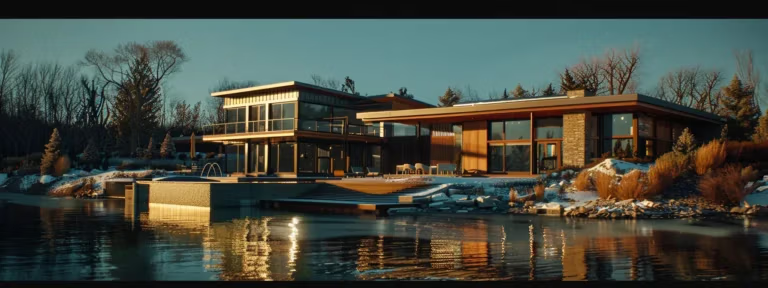If you have noticed some signs that it’s time for a roof replacement, your next question is likely about timing. More specifically, which is the best season for a roof replacement? You know that the shingles on your roof can get damaged by heavy rain, heat waves, and snowstorms. This already eliminates the greater portion of the year.
From the start of winter all through the end of summer and sometimes even into early fall. Unfortunately, this leaves a relatively small window of time where you can conduct a roof replacement in ideal conditions. Let’s go more in-depth about why the best time for these repairs is in the fall.
Reason No1 The right weather conditions
We are still not in the future where robots don’t mind doing hard physical labor in the blazing hot sun of summer. Roof work isn’t easy, and it takes a lot of manpower to be done right. Fall provides the perfect temperature for roofers to work in.
Also, the cooler temperatures are much better for the roofing itself. Temperatures around the fall season ensure that shingles will not be sticking together but will still be able to adhere firmly to the foundation of your roof. However, don’t let yourself get carried away. If you wait too long and get to the cold weather conditions in the winter, the adhesive will not be able to set correctly. And the constant threat of snowfall will not make things easier.
Reason No2 Smaller chance of storms
While this does depend on where you are located, spring and summer both tend to bring heavy storms and unpredictable weather. That makes it much more difficult for roofers to schedule jobs and inspect your roof to assess what needs work. Fall is a bit more predictable since the conditions are much clearer. This makes a complete roof replacement much easier to conduct.
However, as we’ve said, this depends a bit on where you are located. So, if you are in a situation where you are moving to a new area to a house that needs a roof replacement first, experts from Evolution Moving advise you to research the weather conditions and trends there before moving or starting any work. For example, if you are moving in spring, you might realize that, while your roof does need to be replaced, the climate still gives you time to wait for fall.
Or you might notice that (even though fall is still most likely going to be the best season for a roof replacement), the weather conditions at the beginning of summer can also be acceptable if your roof is in dire need of a replacement before you can move there.
Reason No3 Ease of installation
As we have already stated, the fall temperatures make shingles much easier to work with. Depending on the material, shingles can become brittle and easy to break if it gets too cold. However, they can get sticky and difficult to handle if it becomes too warm. Fall most commonly offers the ideal temperature for installing roofs. It ensures roofers can complete your project on time and within the budget.
However, it doesn’t stop at installing shingles on your new roof. The lack of snow and heavy rain makes installing attic ventilation easier. While there are different types of attic ventilation, it is still better to have no weather interference when installing any of them.
Reason No4 Your home will be safe during the winter
Winters are especially tough on roofs for multiple reasons, from heavy snowfall, the freezing temperatures to high winds. The best way to keep your family dry and warm through the winter is to have a properly installed roof ready to defend your home.
If your roof leaks midway through the winter, it can be a big problem. And the fact that most roofers are unavailable during the winter doesn’t make the situation any better. One of the most apparent reasons fall is the best season for a roof replacement is that it helps you avoid roof damage in the winter.
Reason No5 Keeps pests out
Your attic is generally inviting for all kinds of creatures and pests, but it’s especially so in the winter. It is a warm, dry place that you and your family do not visit as frequently as the rest of the house. That makes it an ideal space for bigger pests like raccoons and mice and smaller bugs like roaches and termites. This is another crucial reason fall is the best season for a roof replacement. By replacing your damaged roof in the fall, you can be sure that there will not be any cracks and holes that offer an entrance for pests.
However, it would be best if you keep another thing in mind. If the damage on your roof came from pests like termites, a roof replacement has to involve a thorough cleaning and pest removal. A project of this size can amount to a lot of time, energy, and especially money you must spend. If you’ve been planning to move somewhere else already, you may want to take this as a sign. When deciding whether you should go for an extra long and expensive replacement and renovation vs buying an entirely new home, you have to carefully think about your needs. Don’t be hasty in the decision and consider all the reasons we mentioned in this article.
Why Fall is the Best Time for Roof Replacement
Doing a roof replacement in the fall makes it easy to schedule and quick to complete. Fall is the best season for a roof replacement because moderate temperatures and fewer severe storms usually make installation processes much more difficult. Replacing your house’s roof during the fall season allows you to take many preventative measures before winter.
You can take care of any damage before the snow and ice of winter hit and seal up any holes where critters might enter to find warmth. Living in your house during a roof replacement is also usually challenging. So, doing it in the fall, when most of the family holidays take place, makes it easier to have a reason to spend a lot of time out of the house while you visit your family or go on a vacation.






